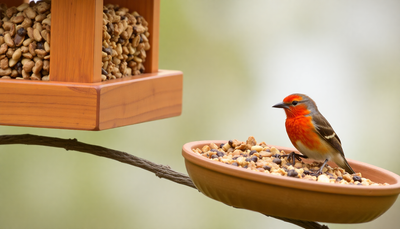Reptile Heat Lamps: Understanding Temperature Range and Care

Reptile heat lamps are essential for maintaining the optimal temperature in reptile enclosures, but have you ever wondered just how hot these lamps can get? Understanding the temperature range of reptile heat lamps is crucial for ensuring the well-being of your scaly companions. In this introduction, we will delve into the fascinating world of reptile heat lamps, exploring the temperatures they can reach and the implications for reptile care. Whether you're a seasoned reptile enthusiast or a newcomer to the world of herpetology, this topic is vital for creating a safe and comfortable environment for your reptilian friends. Join us as we uncover the heat output of these lamps, the potential risks associated with improper use, and the best practices for regulating temperature in reptile habitats. Get ready to shed light on the heat emitted by reptile heat lamps and discover how to keep your cold-blooded pets cozy and content.
What is a Reptile Heat Lamp?
Reptiles are ectothermic creatures, meaning they rely on external heat sources to regulate their body temperature. In captivity, it's crucial for reptile owners to provide the right environmental conditions to ensure the well-being of their scaly companions. One essential component of creating a suitable habitat for reptiles is the use of a reptile heat lamp.
Definition and Purpose of a Reptile Heat Lamp
A reptile heat lamp is a specialized light fixture designed to emit heat, simulating the warmth of the sun. These lamps are essential for reptiles as they help in maintaining the proper temperature gradient within their enclosure. The heat emitted by the lamp allows reptiles to thermoregulate, enabling them to move between warmer and cooler areas within their habitat as needed. This is vital for their overall health, digestion, and metabolism.
Reptile heat lamps also play a crucial role in providing the necessary UVB radiation that reptiles require for synthesizing vitamin D3. This is essential for calcium metabolism and preventing metabolic bone diseases such as MBD (Metabolic Bone Disease). In essence, a reptile heat lamp serves the dual purpose of providing heat and essential UV radiation, mimicking the natural conditions of the reptile's native habitat.
Common Types of Reptile Heat Lamps Available in the Market
-
Incandescent Heat Bulbs: These are the most commonly used heat lamps for reptiles. They produce heat as a byproduct of light and are available in various wattages to suit different enclosure sizes and temperature requirements. It's important to use a thermostat in conjunction with these bulbs to regulate the temperature and prevent overheating.
-
Ceramic Heat Emitters: Unlike incandescent bulbs, ceramic heat emitters produce heat without emitting light. This makes them ideal for use during the night as they do not disrupt the reptile's natural light-dark cycle. They are also long-lasting and emit infrared heat, which penetrates deeply into the reptile's tissues, promoting natural behaviors like basking and thermoregulation.
-
Mercury Vapor Bulbs: These bulbs are a comprehensive lighting solution as they provide both heat and UVB radiation. They are suitable for larger enclosures and species that have high UVB requirements. However, it's essential to monitor the distance between the bulb and the basking spot to ensure that the UVB levels are within the recommended range.
-
LED Heat Lamps: These are a more energy-efficient option compared to traditional heat bulbs. LED heat lamps produce heat without emitting UVB, making them suitable for providing supplemental heat in specific areas of the enclosure. They are also long-lasting and can be used in conjunction with UVB-emitting bulbs for a complete lighting and heating setup.
How Does a Reptile Heat Lamp Work?
Overview of the Heating Mechanism
Reptiles, being ectothermic, rely on external sources of heat to regulate their body temperature. In their natural habitats, they bask in the sun to warm up. In captivity, reptile owners use heat lamps to mimic this natural behavior. These lamps emit light and heat, creating a warm spot within the reptile's enclosure. The heat allows the reptile to regulate its body temperature by moving closer to or farther away from the lamp as needed.
Explanation of the Different Components of a Reptile Heat Lamp
A reptile heat lamp consists of several key components that work together to provide the necessary heat for the reptile. The most crucial part is the bulb itself, which produces both light and heat. These bulbs are typically made of materials that can withstand high temperatures and emit the appropriate wavelengths of light. The type of bulb used can vary depending on the specific needs of the reptile species.
In addition to the bulb, the lamp fixture is essential for safety and proper function. The fixture holds the bulb securely in place and provides the necessary electrical connections. It is crucial to use a fixture that is rated for the wattage of the bulb and designed for use with reptile heat lamps.
Another important component is the reflector, which is often built into the lamp fixture. The reflector helps direct the light and heat downward toward the reptile's basking spot, maximizing the effectiveness of the heat lamp. Without a reflector, much of the heat and light would be dispersed throughout the enclosure, rather than concentrated in the desired basking area.
Finally, the thermostat plays a critical role in regulating the temperature within the reptile's enclosure. This device is connected to the heat lamp and monitors the temperature, automatically adjusting the lamp's output to maintain the desired level of warmth. This is especially important for reptiles that require specific temperature ranges to thrive.
The Zilla Micro Reptile and Amphibian Habitats Arboreal webpage on Talis US offers a wide range of high-quality habitats, ornaments, housing accessories, and food options for reptiles and amphibians. It caters to the specific needs of reptile and amphibian owners, providing a comprehensive selection of terrariums, substrate, food, and care supplies for various species such as turtles, lizards, frogs, and snakes. The webpage's diverse range of products and brands ensures that it meets the preferences of different customers, making it a valuable resource for reptile and amphibian enthusiasts.
Factors Affecting the Temperature of Reptile Heat Lamps
Reptiles, like all living creatures, have specific environmental needs to thrive in captivity. One of the most critical factors in maintaining their well-being is regulating the temperature within their enclosure. The temperature of reptile habitats is influenced by several key factors, each of which plays a crucial role in creating a comfortable and safe environment for these fascinating creatures.
Wattage and Power Output of the Heat Lamp
The wattage and power output of the heat lamp are fundamental considerations when creating the ideal environment for reptiles. Different reptile species have varying temperature requirements, and it's essential to select a heat lamp with the appropriate wattage to meet these needs. For example, desert-dwelling reptiles like bearded dragons may require a higher wattage heat lamp to simulate the intense heat they would experience in their natural habitat. On the other hand, reptiles from more temperate climates, such as some species of snakes, may require a lower wattage heat lamp. Understanding the specific wattage requirements for your reptile is essential for maintaining their health and well-being.
Distance Between the Heat Lamp and the Reptile
The distance between the heat lamp and the reptile is another critical factor in regulating the temperature of the reptile's enclosure. Placing the heat lamp too close to the reptile can result in overheating, while placing it too far away may not provide sufficient warmth. It's important to follow the manufacturer's guidelines for the recommended distance between the heat lamp and the basking spot for the reptile. Additionally, regularly monitoring the temperature at the basking spot using a reliable thermometer can help ensure that the distance is optimal for your reptile's needs.
Type of Enclosure and Insulation
The type of enclosure and its insulation properties significantly impact the effectiveness of the heat lamp. Glass enclosures, for example, may require more insulation to retain heat compared to wooden enclosures. Additionally, the presence of ventilation and airflow within the enclosure can affect how effectively the heat is distributed. It's important to consider these factors when setting up the reptile's habitat to ensure that the heat lamp can maintain the desired temperature levels consistently.
External Temperature and Climate Conditions
External temperature and climate conditions also play a role in regulating the temperature within the reptile's enclosure. For reptile owners living in regions with extreme temperatures, such as very hot or cold climates, additional measures may be necessary to ensure that the enclosure maintains the appropriate temperature. This could include using additional heating or cooling devices to offset the impact of external conditions on the reptile's habitat.
Reptile Heat Lamps: Understanding Temperature Range and Risks
Reptile enthusiasts often rely on heat lamps to create the ideal environment for their scaly companions. These lamps are essential for maintaining the proper temperature within a reptile's enclosure, but just how hot can they get? In this section, we'll explore the temperature range of reptile heat lamps, common temperature settings for different reptile species, and the potential risks of using excessively hot heat lamps.
Temperature Range of Reptile Heat Lamps
Reptile heat lamps are available in a variety of wattages and types, each capable of producing different levels of heat. The temperature range of these lamps can vary significantly, with some models reaching temperatures as high as 120 degrees Fahrenheit (49 degrees Celsius) or more. It's crucial for reptile owners to carefully select a heat lamp that can achieve and maintain the appropriate temperature for their specific reptile species.
Common Temperature Settings for Different Reptile Species
Different reptile species have unique temperature requirements based on their natural habitats. For example, desert-dwelling reptiles such as bearded dragons and leopard geckos thrive in environments with basking spots reaching temperatures between 95-105 degrees Fahrenheit (35-40 degrees Celsius). In contrast, tropical species like green tree pythons and red-eyed tree frogs prefer slightly lower basking temperatures ranging from 85-90 degrees Fahrenheit (29-32 degrees Celsius). It's essential for reptile owners to research and understand the specific temperature needs of their pets to ensure their well-being.
Potential Risks of Using Excessively Hot Heat Lamps
While heat lamps are crucial for maintaining the health and well-being of reptiles, using excessively hot lamps can pose serious risks. One common danger is thermal burns, which can occur if a reptile comes into direct contact with a heat lamp that exceeds safe temperatures. Additionally, overheating can lead to dehydration and heat stress, particularly if the reptile is unable to find a cooler area within its enclosure. It's important for reptile owners to regularly monitor the temperature within the enclosure and ensure that it remains within the safe range for their specific species.
Safety Precautions When Using Reptile Heat Lamps
Reptiles, being cold-blooded animals, rely on external heat sources to regulate their body temperature. It is crucial for reptile owners to monitor and control the temperature within their pet's enclosure. When using heat lamps, it's essential to ensure that the temperature remains within the appropriate range for the specific species of reptile. Failure to do so can lead to health issues such as metabolic problems, poor digestion, and overall stress for the reptile. Regularly checking and adjusting the temperature settings of the heat lamp is vital to maintaining a healthy environment for your pet.
Importance of Monitoring and Controlling the Temperature
Reptiles have specific temperature requirements based on their species, and it's essential to create a suitable environment that mimics their natural habitat. Monitoring and controlling the temperature within the enclosure is crucial for the overall well-being of the reptile. It is important to invest in a reliable thermometer to accurately measure the temperature and make adjustments as needed. Additionally, using a thermostat can help in maintaining a consistent temperature, preventing overheating or sudden drops in temperature. By ensuring the temperature is within the appropriate range, reptile owners can support their pets' physiological functions and overall health.
Tips for Setting Up a Safe and Suitable Heat Lamp Environment
Creating a safe and suitable heat lamp environment for your reptile involves several key considerations. Firstly, it's important to position the heat lamp in a way that provides a gradient of temperatures within the enclosure, allowing the reptile to move between warmer and cooler areas as needed. This mimics their natural behavior in the wild and supports their thermoregulation. Additionally, using a thermostat with the heat lamp can help in maintaining a consistent temperature, preventing overheating or sudden drops in temperature. It's also crucial to choose the right wattage for the heat lamp based on the size of the enclosure and the specific needs of the reptile species. Always ensure that the heat lamp is securely installed to prevent any accidental falls or contact with the reptile.
Potential Hazards and How to Avoid Them
While heat lamps are essential for providing the necessary warmth for reptiles, they also pose potential hazards if not used carefully. One common risk is the possibility of the reptile coming into direct contact with the heat lamp, leading to burns or injuries. To prevent this, it's important to place the heat lamp in a way that the reptile cannot physically reach it. Additionally, always use protective guards or screens around the heat lamp to create a barrier between the reptile and the hot surface. Another hazard to be mindful of is the risk of fire due to overheating or malfunctioning heat lamps. Regularly inspecting the condition of the heat lamp and its electrical components can help in identifying any potential issues early on. It's also advisable to have a backup heat source available in case the primary heat lamp fails.
Incorporating Relevant Information
In addition to the safety precautions when using reptile heat lamps, it's important for reptile and amphibian enthusiasts to have access to high-quality habitats and supplies for their pets. The webpage for Zilla Micro Reptile and Amphibian Habitats Arboreal on Talis US offers a comprehensive range of products, including terrariums, substrate, food, and care supplies for various reptile species such as turtles, lizards, frogs, and snakes. This provides reptile and amphibian owners with the necessary resources to create a comfortable and secure habitat for their beloved pets.
Word Count: 498
Choosing the Right Reptile Heat Lamp
Choosing the right reptile heat lamp is crucial for providing the appropriate heat source for your reptile. Factors to consider when selecting a heat lamp for reptiles include the type of reptile, the size of the enclosure, and the specific heating requirements of the species. Different reptile species have varying heat and light requirements. For example, desert-dwelling reptiles like bearded dragons and leopard geckos require a basking spot with high temperatures, while tropical species such as chameleons and tree frogs need lower temperatures and higher humidity levels. Understanding the specific needs of your reptile is essential in choosing the right heat lamp.
The size of the enclosure also plays a significant role in selecting the appropriate heat lamp. Larger enclosures may require multiple heat lamps to ensure that the entire space is adequately heated. It's important to consider the dimensions of the enclosure and the distance between the heat source and the basking spot to provide the right temperature gradient for your reptile.
Additionally, the specific heating requirements of the species should be taken into account. Some reptiles may require UVB lighting in addition to heat, while others may need infrared heat to mimic the warmth of the sun. Understanding the heating and lighting needs of your reptile species is essential for their overall health and well-being.
Based on the specific needs of different reptile species, there are various heat lamps recommended by experts. For desert-dwelling reptiles like bearded dragons and leopard geckos, a high-wattage halogen heat lamp is often recommended to create a basking spot with temperatures ranging from 95°F to 110°F. These heat lamps provide the intense heat that these reptiles require to thermoregulate effectively.
For tropical reptiles such as chameleons and tree frogs, a lower-wattage heat lamp combined with UVB lighting is often recommended. This setup helps to create a warm and humid environment that mimics their natural habitat. The UVB lighting is essential for these species to metabolize calcium and maintain healthy bones.
After reviewing top search results and expert recommendations, several commonalities emerge in the selection of reptile heat lamps. One common recommendation is the use of ceramic heat emitters for nocturnal reptiles that require heat without light. These heat emitters are ideal for maintaining stable nighttime temperatures without disrupting the reptile's natural light cycle.
Another commonality is the emphasis on using thermostats in conjunction with heat lamps to regulate and maintain the desired temperatures. Thermostats help prevent overheating and ensure that the heat source operates within the safe temperature range for the reptile.
In conclusion, choosing the right heat lamp for your reptile involves considering factors such as the species' specific heating and lighting requirements, the size of the enclosure, and expert recommendations. By understanding these factors, you can provide your reptile with a comfortable and healthy environment that supports their overall well-being.
Conclusion
In conclusion, understanding the temperature output of reptile heat lamps is crucial for creating a suitable environment for your reptile or amphibian. It's important to note that reptile heat lamps can reach high temperatures, and it's essential to monitor and regulate the heat to ensure the safety and well-being of your pet. For a comprehensive range of products and supplies tailored to the specific needs of reptile and amphibian enthusiasts, including habitats, ornaments, housing accessories, and food options, visit Talis US at Zilla Micro Reptile and Amphibian Habitats Arboreal . Their wide selection and unique selling points make it a valuable resource for creating the ideal environment for your reptile or amphibian.






